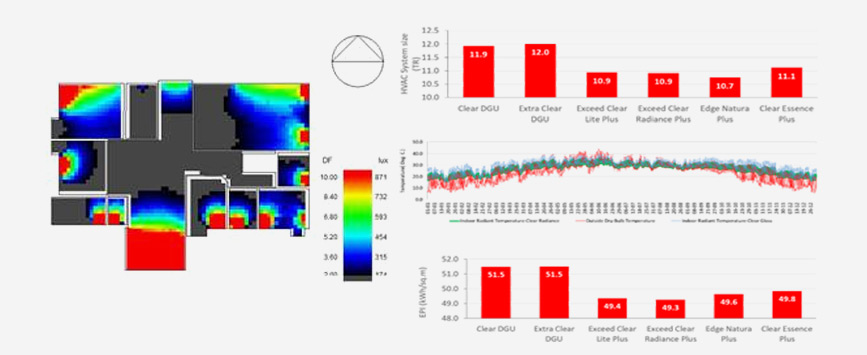The world is speedily advancing towards sustainability, even and especially in terms of architecture. After all, buildings are responsible for around one-third of the total CO2 emissions. Plus, let’s not forget the amount of energy consumed via artificial lighting, heating, and cooling systems, especially in towering corporate structures. There’s a dire need today for ‘Green buildings’ that are cost-effective and healthy, for the occupants in particular and the environment in general.
ENERGY EFFICIENCY THROUGH GLASS – ENERGY SIMULATION STUDY
“Things which can be monitored can be controlled”
Energy simulation tools help measures annual energy consumption in any building. It helps in conducting energy and daylight analysis for different kinds of buildings situated in different climatic zones. It helps in comparing energy use and daylight performance through analysis with different glass options.
For energy simulation analysis, the following inputs are desired from our customers:
- Building design (Either Auto CAD, PDF design) for floor plans, elevation
- Approximate glass requirement
- Building orientation
- Location of the building
- Building activity schedule (Day time building, 24 x 7 building, school building etc.)
- Any other information on building design, a customer wants to incorporate during energy analysis
PMO was introduced in AIS in early 2016. It was implemented to provide end-to-end management of projects and to provide a single point of contact to the client, to construct a detailed work plan to achieve the milestones and communicate the result across the stakeholder audience. Project lifecycle is broken into five parts/stages & worked upon. These stages are:

Initiation
An external kick off meeting with the key stakeholders at the client end is done to understand the project demand & requirement closely. A project charter is made to document the key highlights & an internal kick-off meeting is done with the AIS backend team to appraise every one of the project details.

Planning
Basis the demand schedule of the project, planning is done for three parts viz. raw glass, soft coating & processing. This prior planning significantly reduces the turn-around time for meeting the project requirement and aligns all the former three parts of the process.
Execution
Day to day communication & coordination is done with the customers. Orders are planned & executed as per the customer demand & the DIFOT is kept on check. Customer is kept aware of their orders and plan V. actual is shared.

Monitoring & Control
The project progress & cost is monitored with close coordination with CFTs. The cost is controlled by monitoring the design yield, quality, adherence to timelines. A governance structure is defined wherein project progress is apprised to the key stakeholders at defined time intervals.

Closure
Project supplies & payments are reconciled. NPS is taken from the key stakeholder of the project from the customer end and is used as a reference to work upon the customer pain points if any.


